Talented Melbourne girl becomes a child star, conquers the operatic world and marries an English arts patron. Danielle de Niese’s life story reads like a libretto – with a happy ending.
By Amanda Hooton
July 12, 2025
This story is part of the July 12 edition of Good Weekend.

“I remember thinking, ‘Lots of my friends are really talented, they can dance and act and even sing – but none of them can do this.’ ” Credit: Peter Brew-Bevan
Once upon a time, a plucky young opera soprano set out in search of fame and fortune. Thanks to the fickle hand of fate, various challenges arise on her journey (many of which she has to meet in wildly inappropriate outfits, often including Christian Louboutin or Jimmy Choo shoes). In the midst of a multitude of dramas, an unexpected hero appears, dressed in disguise. Our soprano, like any self-respecting heroine, has a lot going on, but eventually, having achieved triumphant success, she accepts the hero’s hand, accedes to a life of aristocratic glamour (while maintaining her own career) and lives happily ever after.
Does this sound like a suitably operatic plot? No hunting scenes, true; no duels or earthquakes or other typically theatrical story devices. And no tragic fate for the heroine – no murder or mortal illness or immurement in a nunnery. But in many other ways, Danielle de Niese’s life eerily resembles the art form she has spent her life perfecting. “I know!” she cries, making a great sweeping gesture with both arms. “You couldn’t make it up. But it’s a true story!”
Danielle de Niese – Danni to everyone – is always conscious of the alternate paths a life might take. “I’ve basically spent my life telling people Australia gave me wings,” she confesses, dark eyes wide. It’s 9am and pouring with rain in Sydney’s Surry Hills, but de Niese’s ebullience is unaffected. Swathed in black, long hair loose, lashings of gold jewelery at her throat and wrists, she’s eating an enormous egg roll with great gusto. “Had I not gotten, in those few early years of my life, all the chances Australia gave me, who knows what might have happened,” she says. “All the teachers who were so encouraging, telling my parents, ‘She is something unusual.’ Without that, I might not have ever taken opera up as a profession. I might have had a completely different life.”
De Niese, now 46, grew up in Glen Waverley, Melbourne, the daughter of Sri Lankan Burgher immigrants with Scottish and Dutch connections but no history of singing or performance. She was a skinny little kid who loved riding her bike with her younger brother, Andrew, and the local kids. She also, from the age of eight, passionately wanted to become an opera singer.
Not a pop diva, not a rock star: an opera singer. A decade after articulating this dream to her mother, Beverly de Niese, via a drawing (herself on stage in a fabulous puffy dress, framed by enormous curtains), she made her debut at the Metropolitan Opera in New York. She was 19, and she sang Barbarina in Mozart’s Le Nozze di Figaro alongside solid gold opera royalty: Cecilia Bartoli, Bryn Terfel, Renée Fleming.
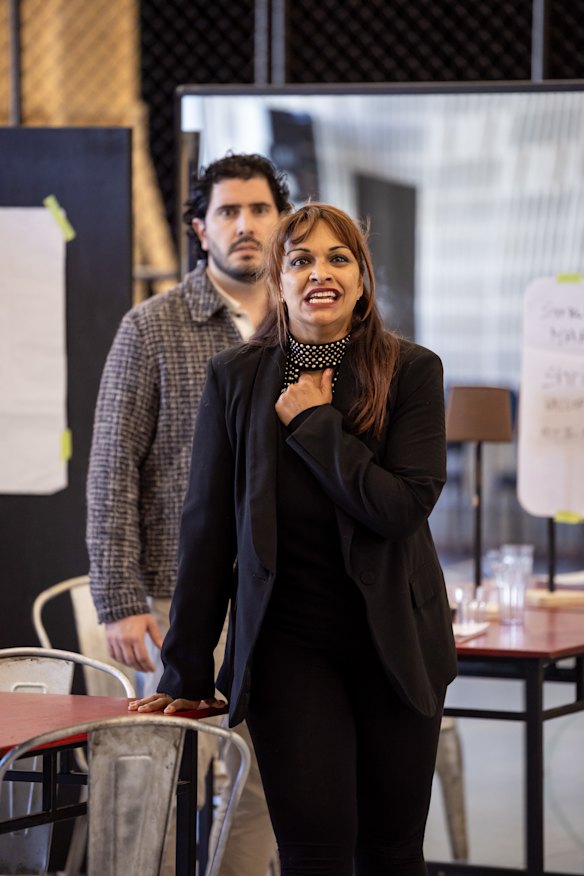
Rehearsing with Abraham Bretón, who plays Don Jose, for her debut in Carmen for Opera Australia.Credit: Daniel Boud
Today, she’s among the world’s most popular sopranos, and has sung at all the major opera houses of the world, in some of the genre’s most famous
roles: Cleopatra, Susanna, Rosina, Poppea. She is in Sydney this winter to perform her debut of Carmen at the Sydney Opera House (and also at the Regent Theatre in Melbourne) in a brand new Opera Australia production.
In addition to all this, de Niese is also married to the third generation of an English family, the Christies, who have, for almost a century, hosted one of the world’s most famous opera festivals. Glyndebourne is set on the grounds of a Christie country estate (there is more than one), in Sussex, in a purpose-built opera house beside their 25-ish-bedroom, 16th-century family home. For several months each year, de Niese and her husband, Gus (Augustus) Christie, have up to 30 members of Glyndebourne’s production team living in their own home, not to mention more than 1000 audience members arriving each afternoon in black tie to picnic among the sheep during the interval of each evening’s performance.
“My colleagues, they see me sometimes, and they’re like, ‘We have no idea how you do this. How do you manage all this?’ ” De Niese leans forward in her chair. “But it’s a joy. It’s easy for me. It’s my métier, it’s my profession.” She looks thoughtful. “I chose opera. And yeah, I won an Emmy and I did all these other amazing things, but I always did it as an opera singer. Somewhere inside my little life, I found my core identity.” She sits back, placing both hands high on her chest, over her heart. “The ultimate way in which I send my soul into the world? Opera. That’s it.”
Young Talent Time
Of all the career paths on earth, how does an eight-year-old choose opera? Do eight-year-olds even know opera exists? And if they do, is it conceivable they look at it and think, “Yes, that is the life for me.”
“Of course it is!” cries de Niese. “By eight, I’d already done theatre; I’d done commercials and voiceover – [ads for Singapore Airlines]; the Wee Sing cassettes [an educational series of song cassettes for children]; TV ads for the Christian Television Association.”
“It’s quite true,” agrees her mother, Beverly, from her home in Los Angeles. “We gave her classical ballet classes, jazz, folk, tap dancing. We gave her piano lessons. She did drama classes. And she loved it. From the time she was three or four, I would watch her in classes, and she would just absorb everything. And when we came home, she would say, ‘Mummy, can we practice?’ ”
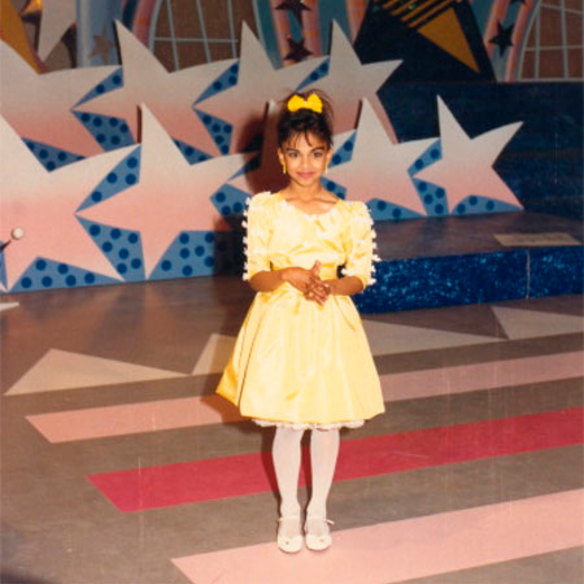
As a nine-year-old “Discovery of the Year” winner on the Young Talent Time TV show.
At nine, already a local star, she entered the Talent Discovery of the Year competition on the famous kids’ TV show Young Talent Time. Surprise, surprise, de Niese “won the whole thing! I was the Young Talent Discovery of the Year!” She looks just as thrilled now as she does on the YouTube clip of her victory: enormous eyes, yellow dress, hair crimped like Madonna’s. (She won a baby grand piano that now resides at Glyndebourne.)
But none of this is opera, right? “True! But that same year, my parents were like, ‘We should get her some classical training so that she’s not just winging it.’ And then, the first time I sang Haydn’s ‘With verdure clad, the fields appear,’ I fell in love.” She clasps her hands. “The thing about opera, in my eight-year-old brain, was that it was my thing. I remember thinking, ‘Lots of my friends are really talented, they can dance and act and even sing – but none of them can do this.’ ”
As she got to grips with her pre-teen repertoire, de Niese began to enter classical singing competitions around Melbourne and win them. “By 10, she had won everything up to the age of 18,” explains Beverly. “She just commanded the stage – once she was up there, you saw only her. We talked to many professionals, and everyone said, ‘Well, she has done as much as she can do in Australia.’ ”
Like many parents of preternaturally gifted children, Beverly and her husband wondered what to do next. “Kids can be ever so talented, and they can have all the desire in the world, but if you don’t give them the training, they can’t go anywhere,” says Beverly. It was, they felt, a question of supporting Danielle to thrive. “We wanted to give her the opportunity. We thought, ‘Well, if she gets to that place [of career success], great. But if she doesn’t, or doesn’t want to, that’s OK too.’ We never pushed her.”
“To this day my mum will say to me, ‘Danni, if you ever want to stop, you should stop.’ And I’m like, ‘Mum!’ ”
Danielle de Niese
Eventually, the de Niese family took an extended holiday in the US to see if there might be opportunities for Danielle there. At the Colburn School, a private performing arts school in LA, Beverly recalls, “They said, ‘We’ll give you a full scholarship, covering everything – singing, dancing, drama, everything – if you stay and study with us’.” And so in 1990, the year de Niese turned 11, the whole family – Danielle, both parents and Andrew – emigrated to the US (where Beverly worked in admin; de Niese’s father, Chris, as a travel executive), positing it as a family adventure.
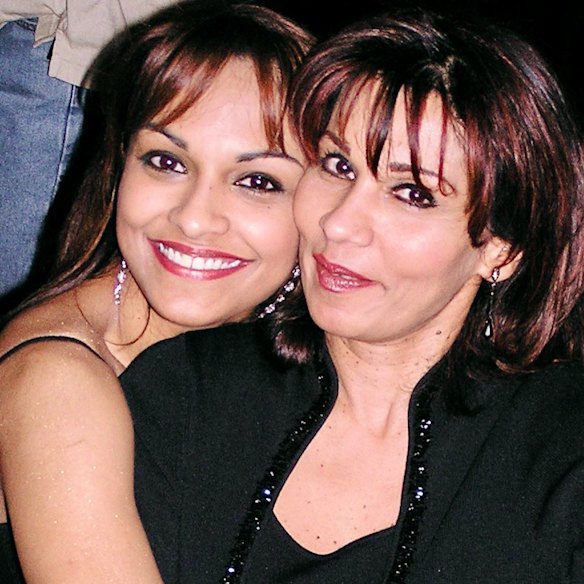
De Niese with her mum, Beverly; the family moved to the US to give the budding star a chance to succeed. Credit: Courtesy of Danielle de Niese
It’s hard to know what small children make of such efforts, however cunningly disguised, made on their behalf. De Niese doesn’t seem to feel burdened by such wholesale devotion; indeed, she seems very close to all her family. “Stage parents!” she exclaims. “I’ve read Andre Agassi – those very complex stories. And the funny thing is, my parents also read those stories. And they would say to me, ‘Danni, I hope you don’t think we’re like that? We are proud of you no matter what.’ And to this day my mum will say to me, ‘Danni, if you ever want to stop, you should stop.’ And I’m like, ‘Mum! I’ve loved singing my whole life! Why would you even say that to me?!’ ”
In Los Angeles, in true Hollywood style, de Niese’s star continued to rise. At 15, she made her professional opera debut with LA Opera. At 16, she won an Emmy for her role as a regular host on an LA TV program, L.A. Kids. At 18, the same year she started university at the prestigious Mannes School of Music in New York, she made her Broadway debut in Les Misérables.
The following year, at 19, she made her Met debut in Figaro – a role which, as her then-agent Alec C. Treuhaft pointed out to her, “every singer on Earth has been trying to get”. She also became the youngest artist ever to be invited to the Lindemann Young Artist Development program – the Met’s celebrated training scheme.
“Danni is such a beautiful singer,” said Gregory B. Keller, who directed de Niese several times in Figaro and was assistant director in the 1998 production. “She’s got the entire package. She moves beautifully. She has an extremely pure and clear sound. I think she’s top of the class.” Long-time Met conductor James Levine called her voice “spectacular”.
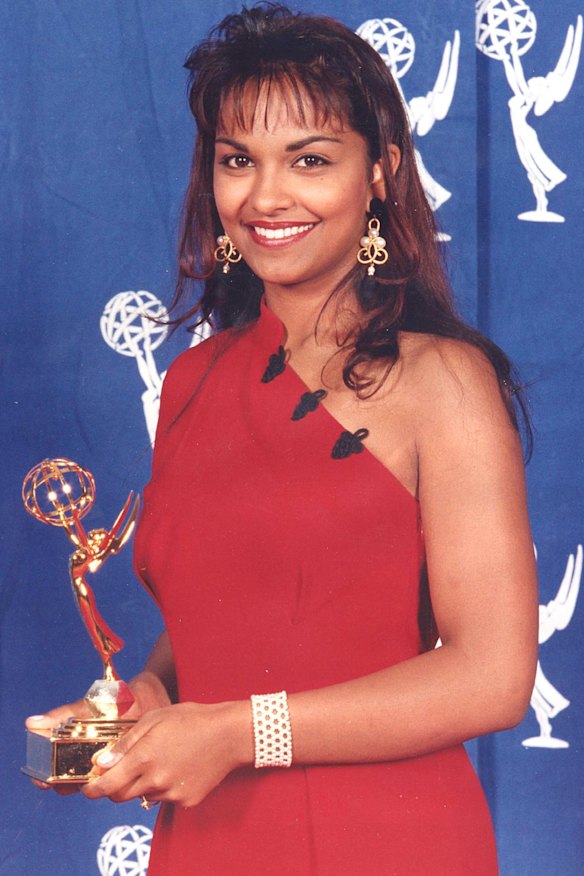
De Niese after winning an Emmy for hosting a TV show, L.A. Kids, aged 16.Credit:Courtesy of Danielle de Niese
During the next five years, de Niese’s career went from strength to strength. In 2001, she performed the role of Cleopatra in a Netherlands Opera production of Handel’s Giulio Cesare; the same year, still only 21, she had a
singing cameo role in Ridley Scott’s Hannibal. In 2002, she was back at the Met with the title role in Ravel’s L’Enfant et les Sortilèges. In 2003, she appeared in Les Indes Galantes at the Opera National de Paris. And then, in 2004, Treuhaft called her with an invitation to audition for the role of Adele in Johann Strauss’s Die Fledermaus, down among the Sussex sheep of Glyndebourne.
Real-life story
Before we talk about Glyndebourne, we should talk about Carmen. And before we talk about Carmen, we should talk about stories. Because the truth is, despite her extraordinary voice, Danielle de Niese has never really been about the singing. Her lyric soprano voice – bright, silvery and flexible, with the agility to range at will among the coloratura trills and embellishments of baroque opera – is one thing. But as she says, her main focus, every time she takes the stage, is to tell a convincing story.
This is not always easy in opera, which, we’ve established, can lean pretty heavily on melodrama as character development: maniacs, murders, mad scenes. Such motivation, however, does not work for de Niese. “I want to draw and tether these characters in a much better way,” she says firmly, “so that everything that happens is so gravitational and believable that you think, ‘That absolutely could have happened in real life.’ ”
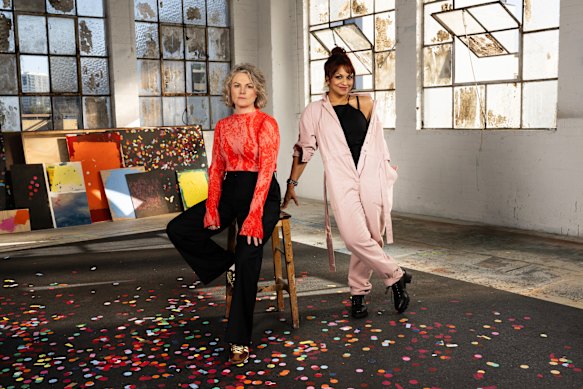
With Carmen director Anne-Louise Sarks, who praises de Niese for her rigour and eagerness to interpret during rehearsal. Credit: Louise Kennerley
“Danni is so hungry for the detail, so incredibly rigorous in terms of intention,” says Melbourne Theatre Company director Anne-Louise Sarks, who will make her opera directorial debut with Carmen. “I can’t speak highly enough of what she’s bringing to the rehearsal room. She’s got a hundred ideas – which is an incredible resource to work with as a director. But she’s also able to take something I give her, and take it away, think about it, then put it into her body and her voice and explore it. That’s an incredibly courageous thing to do. It would be easier to say, ‘I need to stand here and sing it like this.’ “
De Niese has never done that; indeed, rather the reverse. And in so doing, she has sometimes moved off the traditional opera stage altogether. In 2015, she helped create the world premiere of Bel Canto – the Lyric Opera of Chicago’s adaptation of Ann Patchett’s bestselling novel; in 2023 she starred in the West End revival of Andrew Lloyd Webber’s Aspects of Love; a year earlier she showed off her acting chops in a highly praised, hyperrealistic BBC adaptation of the one-woman, one-act opera La Voix Humaine (“The Human Voice”). Watching her weep onscreen, you can’t help thinking the only difference between de Niese and a real, heartbroken woman is that she’s, well, singing.
“The voice, truly, is almost the last thing in my mind on stage,” confesses de Niese. Story is more important than singing; and life is more important than either. When she does school outreach visits, or works as an ambassador for the International Rescue Committee (a post she’s held since 2014), she’s not thinking about being an opera singer. “I’m just myself; a person with dreams. I want kids to know they’re allowed to dream, too.”
Despite its appearance as an uninterrupted parade of triumphs, her own career has had its share of challenges: wardrobe malfunctions, less than stellar reviews; occasions where she went through the wrong exit and ended up out on the street mid-performance, banging to be let back into the venue.
But she seems to enjoy a test. In 2013, she performed Cleopatra in Giulio Cesare at the Met with just eight hours’ notice after the star (Natalie Dessay) contracted a cold. She got the call in the morning, arrived at the Met at 1pm and went on stage that night – to a standing ovation. And in 2020, she suffered a miscarriage from an ectopic pregnancy only days before opening night in La Bohème at the Royal Opera House in London. Eighteen hours before the performance, de Niese was still in hospital. She checked herself out, took the stage and performed the whole show.

Danielle de Niese in her 2005 Glyndebourne performance as Cleopatra in Giulio Cesare. Credit: Mike Hoban
In Carmen, four sopranos will sing the role in the course of the production. But each will map their interpretation on to “the version that Danni and I create”, explains Sarks. “I am just so grateful for her, actually. There are a lot of assumptions that have governed the way [stories like Carmen] have been told for hundreds of years. Danni’s willing to jump into the middle of all that and throw it up in the air.”
A passionate love affair
Only opera – actually, only English opera – could produce a story like Glyndebourne. In the 1920s, an eccentric, opera-loving country gentleman, John Christie, began to gather friends at his Sussex estate to stage annual
pro-am productions of Mozart’s operas. In 1930, the cast included a professional soprano called Audrey Mildmay. According to family legend, John Christie was instantly, utterly smitten. The day they met, he took her on a tour of his beautiful manor house, known as Glyndebourne. Flinging open the door to the master bedroom, he said, only slightly creepily: “And this, my dear, is where we’ll sleep once we are married.” Eventually, the pair did marry, and in the early 1930s John built an actual opera house on the estate – as you do – so that his beloved could perform in the comfort of her own home.
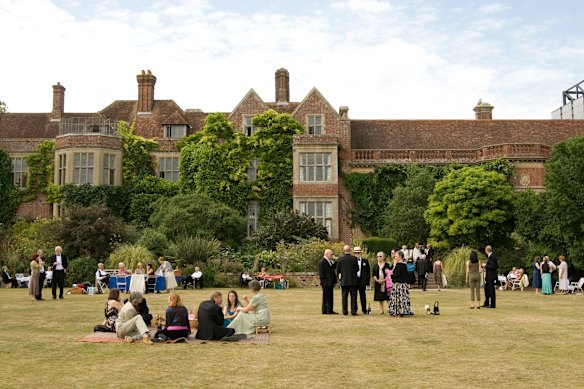
16th-century Glyndebourne House, where de Niese lives with husband Gus Christie, their two children and two dogs. Credit: Alamy Stock Photo
The first Glyndebourne festival was held in 1934 and, today, what began as a jolly family hobby has become a multimillion-dollar business (Glyndebourne receives zero public funding and must cover all its own running costs). The successful eccentricities of the Christie family are still in evidence; in 1992-94, unfazed by a global recession, George Christie, John’s son, built a new 1200-seat opera house; in 2012 Gus Christie, George’s son (and de Niese’s husband), unfazed by significant local objections, opened a wind turbine he’d built that now powers 90 per cent of Glyndebourne.
This is the world – complete with four stepsons, two dogs, about 180 permanent staff, 1215 hectares and an organ room from which the organ (installed by John Christie in the 1920s) had to be removed because it was so enormous it blew the plaster off the ceiling – that Danielle de Niese now calls home.
Opera Australia HQ in Surry Hills seems slightly dull by comparison: neutral walls, neutral chairs, inoffensive opera prints on the walls. De Niese, when I met her for the second time over a snatched sashimi lunch, is once again in black, her hair up in a post-rehearsal claw clip. I’ve read that she never dresses down, and she agrees: she’s been known to travel with 30 pairs of shoes; among her favourite designers are Vivienne Westwood and Donna Karan; she loves Fortnum & Mason hampers and “good wine. Cellar wine!”
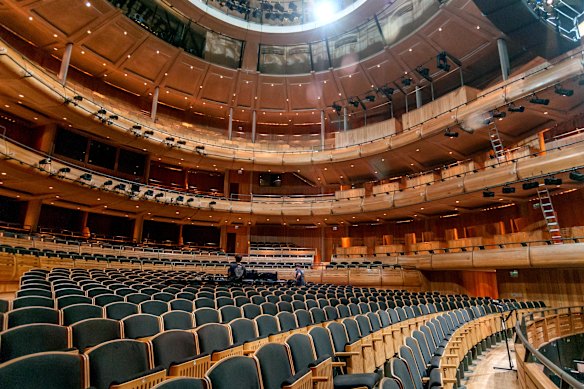
The 1200-seat opera house on Glyndebourne estate grounds. Credit: Alamy Stock Photo
Imagine her, then, one miserable day in 2004, stranded in France when she should have been en route to England to audition for her first role at Glyndebourne. Having missed her flight from Paris, she discovered that her replacement ticket “which cost me 600 euros – so much money!” was to Heathrow, not Gatwick (which is only half an hour from Glyndebourne). The only option she could think of was to spend two hours on the bus getting from one to the other. “I was telling myself, ‘It’s fine, it’s fine. I’ll warm up [her voice] on the bus, I’ll warm up on the bus.’ And then I got on the bus and everyone was sleeping. And I was like, ‘I can’t warm up on the bus!’ ”
The final straw was when she finally arrived at the estate and had to “trek across this soggy lawn wearing these strappy Louboutin sandals and these pleated Alexander McQueen culottes that came down to the ground”. She pauses, momentarily diverted. “So I was looking actually rather chic.”
None of this was ideal. But in what we by now should understand to be her standard response to a challenge, de Niese went into the audition that day – travel-weary, insufficiently warmed up, literally mud-stained – and rose magnificently to the occasion. As her now-husband Gus Christie tells it, two minutes into her first aria, his father George wrote him a note. “Book her.“
When Danielle met Gus
As a result of this 2004 audition, de Niese was scheduled to perform at Glyndebourne in 2006. In the end, she arrived a year early, in 2005, drafted in at the last moment to play Cleopatra in Giulio Cesare after the original soprano fell ill. “And the day I arrived, who was the first person I met?” she asks now with a fine rhetorical flourish, waving her sashimi. “This man, sitting on the [garden] steps playing with his children in a T-shirt, shorts and flip-flops. And he saw me and went, ‘Ah. You are Danielle.’ And I said, ‘Yes.’ And he said, ‘You are Cleopatra.’ And I said, ‘Yes.’ And he went, ‘I’m Gus.’ And I said, ‘Nice to meet you Gus. I’m looking for the rehearsal room.’ And he said, ‘No, you’ve come the wrong way.’ So he redirected me, and I went away, and I remember thinking, ‘God, this place is amazing. Even the gardeners know about opera!’ ”
Of course, it wasn’t the gardener. Gus Christie, grandson of John, has been executive chairman of Glyndebourne since 2000. He and de Niese reportedly had little to do with each other in that 2005 season – Christie (whose first marriage, to Imogen Lycett Green, granddaughter of former English poet laureate John Betjeman, ended in 2004) was presumably busy running the show; and de Niese was certainly enjoying what turned out to be a sensational professional success.
“I remember thinking, ‘God, this place is amazing! Even the gardeners know about opera!’ ”
Danielle de Niese
Twenty-six years old, slim and beautiful, completely at home in the all-dancing, all-singing, Bollywood meets British-empire production, she was, by all accounts, an utterly captivating Cleopatra. “The diva who puts the sex into Sussex,” wrote one dazed British critic. “Every man in the house was watching her,” Glyndebourne’s head of communications, Gillian Brierley, told The New York Times. “You could see their eyes following her back and forth across the stage – it was like Wimbledon.”
By the end of the season, de Niese had cemented her place as an international star; and Glyndebourne had secured her return the following year. It was during this 2006 season, she says, that the prospect of romance between her and Gus first appeared. Christie concurs: this was the year, as he likes to put it, that he “threw his hat into the ring”. De Niese, perhaps surprisingly, was circumspect about the whole thing. Her previous 6½-year relationship with an Italian singer had only recently ended and her next job was in the Netherlands. “I told Gus, ‘Look, we can date, but I’m not coming back here. I know everyone here!’ ” She shakes her head. “We didn’t tell anyone for ages. I think people were sort of like, ‘Why’s he always going to Amsterdam?’ ”
The pair dated internationally for two years before Christie proposed in that well-known hotspot of romantic glamour: Bowling Green, Ohio. “I got the true shock of my life!” De Niese puts her fork down. “Gus had given me a Valentine’s card, and there was this box, and I thought, ‘How lovely! A trinket from the card shop!’ ” She scrolls through her phone, and shows me an image of a tiny clear plastic box containing a white cotton wool pad, on which sits a sparkling, heart-shaped pink crystal. “I thought it was one of those games we had in the ’80s where you had to get the little metal balls into a hole!”
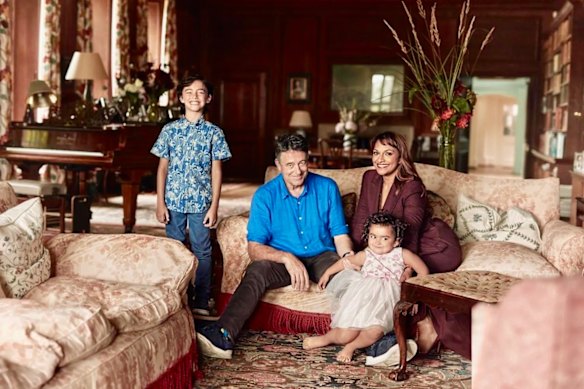
With Gus Christie and their children Bacchus and Sheherazade, who have travelled with her widely, including to Australia. Credit: Tom Griffiths
It was, in fact, a Sri Lankan pink sapphire. De Niese opened the box, the sapphire dropped to the floor – and at some point in the ensuing chaos, Christie explained that he wanted it to be the centre of an engagement ring. The pair married in London in December 2009 (de Niese wore custom-made Donna Karan trimmed with white ostrich feathers).
Since their marriage, de Niese has continued her international career, including at Glyndebourne – she is contracted for her roles there like any other singer, no special treatment – but otherwise, she says, she takes on as little or as much of the family business as she likes. Both her children – Bacchus, born in 2015, and Sheherazade, born in 2020 – have travelled with her all over the world.
Motherhood has challenged her at times. Leading up to Bacchus’s birth, and briefly afterwards, de Niese lost her voice – “I was singing these nursery rhymes with a five-note range and whispering, ‘Don’t judge me!’ ” – and wondered if she’d ever sing again. Undaunted, she went back to work three weeks after his birth, and her voice returned, rounder and richer than before her pregnancy. It shifted again after Sheherazade’s birth, eventually enabling her to take on the often mezzo-soprano role of Carmen.

Magazine Good Weekend The July 12 Edition
Here in Australia, Gus and Bacchus are due to arrive as soon as the English school year finishes (it’s Christie’s first time away from Glyndebourne during the festival in more than a decade), and Sheherazade is already in situ. “I’m very blessed in my life,” says de Niese finally, sitting back. “There have certainly been challenges but I have prevailed so far. And I’d like to think that, god forbid, if anything happens to any of us, I can somehow remember, ‘Well, I’ve had a lot of other blessings.’ ” For a moment she looks doubtful. “Sometimes I do worry that it can’t last.”
But at this point, at least, there seems no need for concern. At the end of our second interview, I walk down to the carpark with de Niese and see a little five-year-old face in the car that arrives to collect her; a cloud of dark hair and bright eyes peering from behind a smiling, formidable-looking English nanny.
“My princess!” cries de Niese, diving into the back seat. Sheherazade pretends to be asleep, smiling widely. “She’s sleeping!” stage-whispers de Niese, covering her face with kisses. “The Princess Is Fast Asleep!”
If ever an opera were to have a happy ending, surely this would be it.
To read more from Good Weekend magazine, visit our page at The Sydney Morning Herald, The Age and Brisbane Times.

Leave a Reply